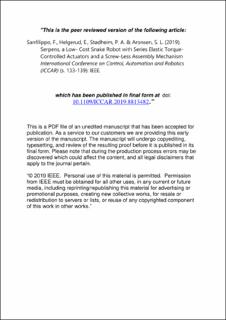| dc.contributor.author | Sanfilippo, Filippo | |
| dc.contributor.author | Helgerud, Erlend | |
| dc.contributor.author | Stadheim, Per Anders | |
| dc.contributor.author | Aronsen, Sondre Lieblein | |
| dc.date.accessioned | 2020-02-20T11:20:36Z | |
| dc.date.available | 2020-02-20T11:20:36Z | |
| dc.date.created | 2019-05-16T17:39:09Z | |
| dc.date.issued | 2019 | |
| dc.identifier.citation | International Conference on Control, Automation and Robotics (ICCAR).2019, 133-139. IEEE. | en_US |
| dc.identifier.isbn | 978-1-4673-7522-1 | |
| dc.identifier.uri | https://hdl.handle.net/11250/2642872 | |
| dc.description | This is a PDF file of an unedited manuscript that has been accepted for publication. As a service to our customers we are providing this early version of the manuscript. The manuscript will undergo copyediting, typesetting, and review of the resulting proof before it is published in its final form. Please note that during the production process errors may be discovered which could affect the content, and all legal disclaimers that apply to the journal pertain.
“© 2019 IEEE. Personal use of this material is permitted. Permission from IEEE must be obtained for all other uses, in any current or future media, including reprinting/republishing this material for advertising or promotional purposes, creating new collective works, for resale or redistribution to servers or lists, or reuse of any copyrighted component of this work in other works.” | en_US |
| dc.description.abstract | Even though a few examples of elastic snake robots exist, they are generally expensive and tailored to custom-made hardware/software components that are not openly available. In this work, Serpens, a newly-designed low-cost, open-source and highly-compliant modular snake robot with series elastic actuators (SEA) is presented. Serpens features precision torque control and stereoscopic vision. Only low-cost commercial-off-the-shelf (COTS) components are adopted. The robot modules can be 3D-printed by using Fused Deposition Modelling (FDM) manufacturing technology, thus making the rapid-prototyping process very economical and fast. A screw-less assembly mechanism allows for connecting the modules and reconfiguring the robot in a reliable and robust manner. By using a low-cost sensing approach, functions for torque sensing at the joint level, sensitive collision detection and joint compliant control are possible. The concept of modularity is also applied to the system architecture on both the software and hardware sides. The software architecture is based on the Robot Operating System (ROS). This paper describes the design of Serpens and presents preliminary simulation and experimental results which illustrate its potential. | en_US |
| dc.language.iso | eng | en_US |
| dc.publisher | IEEE | en_US |
| dc.relation.ispartof | International Conference on Control, Automation and Robotics (ICCAR) | |
| dc.title | Serpens, a Low- Cost Snake Robot with Series Elastic Torque-Controlled Actuators and a Screw-Less Assembly Mechanism | en_US |
| dc.type | Chapter | en_US |
| dc.description.version | acceptedVersion | en_US |
| dc.source.pagenumber | 133-139 | en_US |
| dc.identifier.doi | 10.1109/ICCAR.2019.8813482 | |
| dc.identifier.cristin | 1698438 | |
| cristin.unitcode | 222,58,6,0 | |
| cristin.unitname | Institutt for realfag og industrisystemer | |
| cristin.ispublished | true | |
| cristin.fulltext | preprint | |
| cristin.qualitycode | 1 | |
